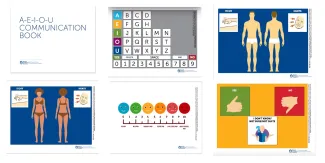Partner-assisted spelling
The best time to learn any strategy is before it is needed. This is true for partner-assisted spelling too. Of course, it can be introduced at any time but we certainly encourage you to be proactive if possible!
Why do you want to learn partner assisted scanning? It is all about options. No one communication strategy, no matter how sophisticated, can be used in all situations. Positioning, lighting, noise, the environment — they all play a role.
Download your own copy of our A-E-I-O-U/Body/Pain scale book
Download your booklet
Patient-customized communication tabbed flip book
We have had so many people with ALS express frustration with trying to quickly communicate (often with speech) a simple and often repeatedly communicated and predictable message, such as:
- "Adjust the strap on the BiPAP mask."
- "Put pillow behind my neck."
- "Don’t forget to lock the brakes."
Similarly, communication partners have reported being very frustrated and often feeling very guilty when they can’t understand a message, especially when they realize that the message is a communicated regularly in the same context, often multiple time a day. In an effort to create a format for people to use, we created a blank, tabbed flip book to give to people with ALS and their families.
Watch a quick video tutorial on our customized tabbed flip book:
Typical instructions for a person with ALS and their communication partner(s)
- Identify situations or context throughout the day in which you say the same thing and you want to make sure people always understand exactly what you are saying.
- Write each context on one of the tabs at the bottom of the flip chart. A few examples include: positioning, food, personal care, bed, technology, social, bathroom.
- As you think of a predictable message you communicate in each context, write that message down (or direct someone to write it down) in one of the boxes on the appropriate page.
- Add messages as they occur to you over time.
- Invite your communication partners to make suggestions, especially for contexts in which they are typically with you and may be supporting you.
- When you think you have a good start, give us a copy of what you have done and we will make your pages, laminate them and bind them together.
- After we give you a clean copy of your customized communication tabbed flip book, try using it.
- Identify a way you are going to tell your communication partner "yes" when they scan through your flip book with you.
Typical instructions for communication partners
- If you don’t understand what is being said, report that you cannot understand and ask “Is it in your flipbook?”
- If the answer is "yes," read through and point to each of the tabs until you are told, "yes." (You have already established together what that ‘yes’ signal will be.)
- Turn to the appropriate page and then go through each of the messages. Some people have preferred to first review columns. (Is it column one?, column two?, etc.), while others prefer to quickly read through each message on the page.
The Patient Customized Tabbed Flip book will likely need to be updated regularly. Some contexts will be added as medical status changes, while others may be removed (add a g-tube page, while possibly removing or significantly modifying the food page).
